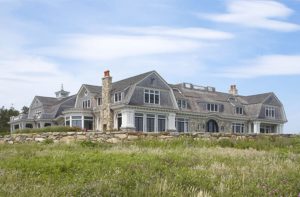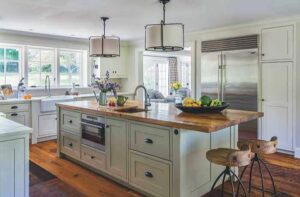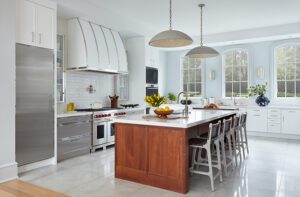A Mix of Old and New in Lyme, Connecticut
October 15, 2020
Text by Paula M. Bodah Photography by John Gruen
Most mornings, Nancy FitzPatrick pours herself a cup of coffee and settles in by a kitchen window to greet the day. As she looks out over the five-plus acres of lawn and meadow and woods around the house she shares with her husband, Paul, she appreciates the peaceful environment. It’s just her—and the animals. Lots of animals.
“Our yard is filled with wildlife,” she marvels. “We see fox and deer and rabbits and turkeys, and of course, coyotes.” Add to that the hawks that soar above, the butterflies that flit from plant to plant, and the neighbor’s horses grazing nearby, and the whole scene is the very definition of bucolic.
While that rural feel is a big part of what the FitzPatricks loved when they were house hunting, they were equally charmed by the neighborhood, an enclave of homes built by Skip Broom and his crew at HP Broom Housewright. Broom acquired the thirty-five-acre expanse of land in the late 1980s with the goal of saving about-to-be-razed eighteenth-century houses around New England. “We’d buy a house for very little money, disassemble it, save everything worth saving, transport the pieces back to the site, and use them to build a new house,” he says.
Every one of the half-dozen dwellings was designed around a historic building that he found and rescued. At the core of the FitzPatrick house is the 1750s New Hampshire blacksmith shop that forms today’s great room. “This is the only home there that came from a commercial, rather than residential, building,” Broom explains.
As with the other structures in the enclave, he took the shop apart and brought everything that was salvageable to Lyme.
He designed the rest of the house to look as if it was constructed over generations, using varied woods, types of siding, and, in some cases, paint to reflect different periods. And everywhere it was possible, he used salvaged antique materials, from the great room’s old floorboards to the kitchen addition’s ceiling beams.
It may sound counterintuitive to talk about updating the decor in a house that’s meant to look old, but that’s exactly what interior designer Carol-Ann Speros was enlisted to do for the FitzPatricks, who are the home’s third owners. “The goal,” says Speros, “was to take it in a fresher direction while being respectful of the history.”
In this case, fresher translates to a lighter, brighter palette in shades of soft, warm grays that let the dark reclaimed wood stand out. The great room’s gas fireplace was converted back to wood-burning and reimagined as a clean expanse accented with a new bluestone hearth and a hand-forged-iron fire screen crafted by one of Broom’s craftsmen. The FitzPatricks’ collection of art, an eclectic mix of Dutch, French, and American Western art, looks right at home with the blend of antique and contemporary furnishings anchored by a custom Merida rug of wool and sisal with linen binding.
In the kitchen, Speros painted the cabinetry pale gray and treated the island to a new top of concrete. She replaced the heavily textured tile backsplash with a counter-to-ceiling wall of simple subway tile and wrapped the other three walls in Phillip Jeffries burlap. A vintage French Holophane light fixture adds a stylish twist to the subtly industrial ambience.
The FitzPatricks delight in their home, inside and out. “Carol-Ann is incredibly talented, and Skip has a great eye and great vision,” FitzPatrick says. “Together, we brought the house to the level it deserves.”
Project Team
Architectural design and construction: Skip Broom, HP Broom Housewright
Interior design: Carol-Ann Speros, Carol-Ann Speros Design
Share
![NEH-Logo_Black[1] NEH-Logo_Black[1]](https://www.nehomemag.com/wp-content/uploads/2022/08/NEH-Logo_Black1-300x162.jpg)




















You must be logged in to post a comment.